The third part on Pompeii is about the two Eau de Parfum Baccanale and Aura Pompeiis, with which I would like to conclude the small series on the Italian niche fragrance label and its creations inspired by Roman antiquity. My last two articles Pompeii – At the foot of Vesuvius and Julia and Hortensia by Pompeii – Airy fragrance pleasure offer all those interested further information about the brand itself and its eaux de parfum Valeria, Menandro, Julia and Hortensia.

Baccanale – The debauchee
Baccanale is dedicated to the Bacchanalia, the vicious celebrations of the Bacchus cult in honor of the god of wine of the same name, which were so debauched, orgiastic and nefarious that the cult was eventually even banned by decree of the Roman Senate. In Pompeii, the so-called Mystery Villa, which is considered an archaeological highlight, contains numerous frescoes that are believed to be connected to the aforementioned cult of Bacchus and which probably inspired the Pompeii brand to create them.
Transgression is pleasure, and there was nothing more transgressive than the bacchanalia. In Roman times, the Bacchanal was a festival of reconciliation. The name is derived from the rituals in honor of Bacchus. It was an orgiastic festival that later became the propitiation of the gods on the occasion of the sowing and harvesting of the grain. At the bacchanalia, all kinds of transgressions were acted out, and even the most repressed indulged in drinking and mixing the sexes.
From a fragrance that revolves around the theme of debauchery, one would certainly assume that it is also almost out of control in terms of fragrance notes. However, the Pompeii label only used five olfactory ingredients for Baccanale, namely jasmine, saffron, ambergris, cedarwood and oakmoss.

Baccanale is a fragrance to my taste from the first sniff. Very sweet indeed, but with notes of roasted sugar reminiscent of caramel and candy floss, the eau de parfum opens in a seductive and gourmand-delicious way. A glance at the fragrance notes quickly shows me which creation Baccanale makes me think of right from the start. The name also reveals certain similarities. It is, of course, Baccarat Rouge by Maison Francis Kurkdjian. Gradually, the magnificent sweetness of the opening wears off somewhat and allows other olfactory components to come into play.
The creation calms down, becomes more subtle and powdery-creamy. The saffron is very restrained, flowing into the caramel sweetness, which is nuanced by light jasmine, while the warm notes of ambergris and earthy-powdery oakmoss provide a wonderful rounding. Perfect for all fans of gourmand-sweet and creamy-soft creations with BR540 vibes. In my opinion, it’s more for cooler days, but absolutely suitable for everyday wear and the office. ❤️
Aura Pompeiis – The light one
Aura Pompeiis is dedicated to the special atmosphere brought to the Roman Empire by merchants traveling by sea from the provinces in the Orient. Spices and beguiling essences from the East were brought together by Roman perfumers to create fine fragrance compositions. Aura is the Latin word for breath and so this eau de parfum could also be a tribute to the fragrances and perfumers of Pompeii. Anyone thinking of an opulent creation that is rich in spices and components is wrong. Aura Pompeiis appears to be light, airy and powdery, as the ingredients reveal: Lemon, pink pepper, iris, musk and woods.

As was to be expected, Aura Pompeiis is a light caliber. Fresh, woody and subtle, the eau de parfum is infused with a tart, fruity lemon note and a gentle peppery spiciness. Like a fragrant breeze, the creation provides a delicate and subtle olfactory background that is very transparent and light. Rather austere in nature and lacking in sweetness, Aura Pompeiis is a fragrance that could appeal to those who prefer gentle compositions with a light presence and an equally long-lasting finish. In fact, the fragrance evaporates very quickly on my skin, which is why I had to spray it on several times for this test. It is not a creation that focuses on powdery notes and iris, but rather on crystalline-fresh and light woody facets. If you are looking for a really light and airy fragrance for summer temperatures, I can only recommend Aura Pompeiis.

Be First to Comment